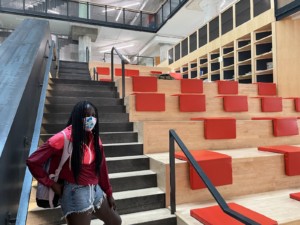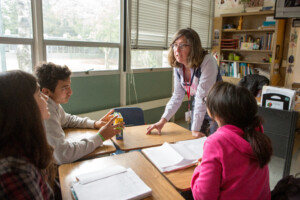Design Integrated Learning Pathways to Realize Your Portrait of a Graduate
Key Points
-
Portraits of a Graduate from school districts across the country tend to identify six similar skill sets necessary for their students to thrive in their lives.
-
Schools and districts have difficulty ensuring that all students have consistent opportunities to practice these skill sets, and to assess their outcomes in these areas.
-
Designing Integrated Learning Pathways can be a key method for schools to ensure that all students have consistent access to Portrait connected learning experiences while minimizing new burdens on teachers.

By Josh Weisgrau and Kelly Mills
Over the last decade, since school districts around the country began to adopt the Portrait of a Graduate model to define a vision for their learners’ outcomes, we have heard a similar story from many district leaders about these efforts. Typically they speak of the enthusiasm that this vision brings to the community, particularly when their Portraits have been designed with input from all community members including teachers, students, and families. Portraits of a Graduate focus on the mindsets and skill sets that enable lifelong learning, success in all careers, and personal fulfillment—the attributes that have received great attention in the movements for 21st Century Learning and increasing uncertainties about the technical skills and knowledge that will be most useful in a rapidly changing future.
However, while school leaders find inspiration in the collective buy-in (which has become increasingly rare to develop in other areas of school), they also tend to express concern over the difficulty in ensuring that students are achieving these outcomes. While the skill sets and mindsets represented in Portraits of a Graduate have received growing attention, there are still many fewer available systems-wide resources and support for achievement and assessment than there are for academic goals. Meanwhile, the programs and supports that do exist tend to address only particular skills rather than the whole Portrait. As school leaders add more and more of these programs in an attempt to fulfill the complete vision of their Portrait of a Graduate, they also often engender “initiative fatigue” and burnout from the educators and support staff charged with implementation.
Portraits of a Graduate focus on the mindsets and skill sets that enable lifelong learning, success in all careers, and personal fulfillment—the attributes that have received great attention in the movements for 21st Century Learning and increasing uncertainties about the technical skills and knowledge that will be most useful in a rapidly changing future.
Josh Weisgrau and Kelly Mills
How can school districts deliberately and systematically create the structures that enable all learners to become their envisioned Portrait in public schools that are already overtaxed and strained? That is the question our team sought to answer as we began an effort to examine the promise and pitfalls of the Portrait of a Graduate. In our recently released report, Shifting Education with Learning Pathways: Becoming Your Portrait of a Graduate, we share what we have learned about both the Portrait of a Graduate model itself and offer a systematic approach to integration that we see as a key to success in learners achieving the vision of the Portrait.
The Skills that Portraits of a Graduate Say are Necessary for Learners to Thrive
We began by analyzing the content of a sample of Portraits from school districts across the country. While Portraits are designed uniquely by each school district with input from their communities, we found an overwhelming alignment across them in terms of what skill sets are emphasized. In our analysis, 90% of named attributes across all 69 Portraits we studied are aligned to the following six skill sets:
- Analyze to Understand
- Care For and Contribute to Society
- Collaborate Across Difference
- Communicate in All Media and Modalities
- Create to Solve and Share
- Practice Self Awareness and Regulation

While the specific terms used to specify these attributes vary, there is significant unity in the nature of the outcomes being expressed. School leaders and PoG design teams can leverage these resources to support schools and districts in customizing the specific contexts of their own community-developed Portraits.
While districts across the nation agree that these six skill sets are essential for learners, they face challenges in operationalizing them systematically. Each skill set is broadly defined, universally applicable, and deeply interconnected, making it difficult to concretely align them to curricular and pedagogical decision making. They also do not directly correlate to the current assessment and credentialing paradigm, which relies heavily on standardized tests and course grades.
Integrated Learning Pathways Make the Vision of a Portrait More Achievable
In our direct work with districts, we have seen that a first step in making these attributes concrete is to identify observable practices within these skill sets at each developmental stage or grade level. Schools can use these identified practices to design and define “horizontal” learning pathways that intersect each academic “vertical,” creating a cross-cutting curriculum that allows teachers to see the specifics of how they can implement Portrait practices in their contexts. This reduces the burden on teachers to identify, on their own, every necessary opportunity to integrate Portrait skills, and enables them to concentrate their expertise on ensuring those integrations meet the needs of each of their individual students.
Partnering with districts from across the nation, we have co-designed Integrated Learning Pathways to identify and implement opportunities for students to develop Portrait of a Graduate skill sets cumulatively through each grade and complementary across subjects. This approach allows the burden of implementing a Portrait vision to be more shared between teachers and leaders and reduce the impact of “initiative fatigue.”
This horizontal approach to creating a Portrait of a Graduate learning pathway also allows districts to more seamlessly integrate new priorities by aligning them with the Portrait pathway, further reducing the burnout caused by continued introduction of new initiatives and programs. In our paper, we share how Indian Prairie School District in Illinois has leveraged this approach to align their focus on Computational Thinking to their Portrait implementation. Portrait attributes are broader than computational thinking alone; however, in this case, computational thinking was a productive framework to operationalize universal and crosscutting Portrait attributes into classroom teaching and learning. Indian Prairie’s Director of Innovation, Brian Giovanini shared, “As we thought about computational thinking, and really, the skills and competencies that feed underneath that term, it really helped us visualize parts of the Portrait and build a learning pathway for our students to get to that outcome.”

We recommend district leaders leverage Integrated Learning Pathways to align teaching and learning to their Portrait of a Graduate and ultimately better prepare students for a successful future.
Josh Weisgrau is Chief Learning Officer, Learning Experience Design at Digital Promise
Kelly Mills is Director of Learning Pathway Design at Digital Promise.






kourtneymulligan
Thank you for any other fantastic post. Where else could anyone get that type of information in such a perfect means of writing? I've a presentation subsequent week, and I am on the look for such info.
hbxemory05
Hurrah! Finally I got a website from where I be able to in fact obtain helpful facts concerning my study and knowledge.
barrettbowmaker
Outstanding post however , I was wanting to know if you could write a litte more on this topic? I'd be very thankful if you could elaborate a little bit further. Bless you!